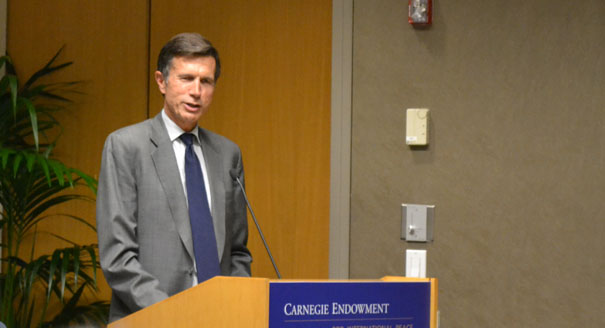Registration
You will receive an email confirming your registration.
Often lauded as a strategic partnership, the multi-dimensional U.S.-India relationship has faced significant challenges in the past year. Ahead of the upcoming U.S.-India Strategic Dialogue, where does the partnership stand, and what could take it forward?
Assistant Secretary of State Robert Blake delivered a keynote address assessing the relationship and the U.S. administration’s thoughts on the Strategic Dialogue. Following his remarks, Alyssa Ayres of the State Department and Diane Farrell of the U.S.-India Business Council discussed the economic and defense dimensions of the relationship. Carnegie’s Ashley J. Tellis moderated.
Stronger Than Ever
The U.S.-India Strategic Dialogue offers an important moment to take stock of the bilateral relationship and allows both sides to consider a wide variety of issues, Tellis said.
- Unwarranted Pessimism: While some critics see the U.S.-India relationship as flagging and falling below expectations, this pessimism is unwarranted when viewed over the long term, Tellis said. He noted that the U.S.-India relationship is not sidetracked by short-term problems and that the rapid growth of the relationship is unprecedented even compared to ten years ago.
- Nature of the Strategic Dialogue: Blake agreed, noting that this Strategic Dialogue will be the third of its kind. It will include a full week of activities which should serve in part to inform the people of both nations why the relationship matters.
- More Than Ever: Blake argued that the relationship has not been oversold and in fact matters now more than ever. He stated that never before have India and the United States mattered more to each other, and never before has the relationship mattered more to the rest of the world.
- A Wide Spectrum: Blake argued that the bilateral relationship is bigger than the next deliverable. The United States and India collaborate on a wide spectrum of issues, including on Afghanistan, regional economic integration, regional security architectures, a bilateral investment treaty, energy, and science and technology. He concluded by noting that the Strategic Dialogue allows the United States and India to take a “whole-of-government” approach to mutual areas of interest, and to apply collective solutions to global problems.
- Looking Forward: Going forward, the United States has three goals, Blake said: (1) to leverage all aspects of existing bilateral cooperation to help the peoples of both countries, (2) to push the envelope on existing cooperation, and (3) to seek out additional areas of cooperation and realize them.
Cooperation At Every Level
The panelists discussed the growth and various forms of U.S.-India cooperation:
- Strategic, Economic, and Knowledge Cooperation: Ayres noted that an enormous variety of issues characterize this new and expanding relationship. In particular, she highlighted cooperation in the strategic, economic, and “knowledge” spaces. She stated that the relationship is succeeding because it is putting together substantial resources in order to effect tangible results.
- The Potential for Economic Ties: Farrell pointed out the tremendous opportunities for strengthened economic ties in the U.S.-India relationship, noting that 400,000-600,000 jobs need to be created in India every month just to keep up with India’s demographic dividend. She stated that both nations have committed to $500 billion in trade by 2020. In particular, she noted that the bilateral investment treaty could play an important role in the two countries’ bilateral economic relationship in the near future.
- The Defense Relationship: Tellis noted that while most aspects of the U.S.-India relationship will be propelled by people-to-people connections at the grassroots level, the defense relationship still needs the active involvement of governments in order to function. In that relationship, Tellis argued that there have already been significant achievements: India and the United States have alleviated their mutual suspicion of each other’s motives, which has laid the groundwork for overcoming Indian suspicions about technology transfers. Now, Tellis noted, the main argument is over the nature of the strategic partnership, an argument which in and of itself emblematizes the strength of the relationship. Tellis cited the unadulterated successes of the military-to-military relationship and strategic cooperation, and noted progress—as well as room for improvement—in the areas of defense sales and defense industrial cooperation.
Tellis concluded by noting that the U.S.-India relationship is likely to stay strong and continue growing. He argued that the most visible obstacle – India’s future economic slowdown – is unlikely to severely impact the relationship. Even if India muddles along at 6 percent growth, its economic importance will still guarantee close ties with the United States. But if India cannot overcome its internal political paralysis, leading to a severe contraction of growth rates, the relationship’s luster could potentially fade. Tellis expressed optimism, however, arguing that structural problems can only injure India’s growth if the Indian government fails to remedy them—which seems unlikely, given the Indian government’s past record of being pushed to a solution by impending crises—and that the fundamentals of the Indian economy remain strong.
This event was supported by the Indian Council for Cultural Relations.
